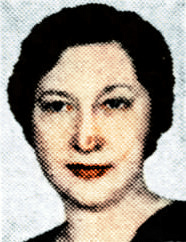
Roving Reporter
By Ernie Pyle
In Italy – (by wireless)
All the highways from Naples north are thick with speeding convoys of supplies, day and night.
Lights are used right up to the combat zone. Both British and American trucks crowd the roads. Drivers pound the big trucks along at 40 and 50 miles an hour, and the main highways are no place for a nervous Nellie.
The highways over here were originally good macadam, but now they are filled with holes from the intensity of the traffic. Engineers work on them constantly.
At the edges of the cities, the roads are wide and lined with stately sycamore trees, you feel as though you were driving through a beautiful tunnel.
Both the American and British armies have put up thousands of stenciled and painted signs along the roads, directing drivers to the numerous units.
When you come to a central crossroads you can see anywhere up to a hundred signs clustered on top of small stakes, like a flower garden in bloom.
If you were really puzzled about your destination, you’d have to pull off and study the hodgepodge for five minutes before finding out anything.
Somebody in our Army must have been a roadside advertising man before the war, for we have all kinds of signs along the highways in addition to the direction signs. They are tacked onto trees, telephone poles and posts.
Signs Burma Shave style
There are many in the Burma Shave poetic style, the several phrases being on separate boards about 50 yards apart, such as this one:
If you leave… good clothes behind… you may need them… some other time.
That’s an admonition against the American soldier’s habit of abandoning gear when he gets more than he can carry.
Another one in Burma Shave fashion, and of dubious rhyme, says:
Some like gold… some like silver… we always salvage… bring it, will you?
There are also frequent warnings against venereal disease, and one sign way out in the country says, “Is your tent clean?” A lot of frontline soldiers who haven’t even been in a pup tent for months would get a laugh out of that one.
As we advance mule by slow mile across the Italian mountains and valleys, our many command posts are set up wherever possible in Italian farm or village houses.
The house are mostly all alike. They are very old and substantial-looking, yet they shake all over from the blast of our nearby guns.
Sometimes the Italian family still lives in one room of the house while the Americans occupy the rest. At other times the family has gone – nobody knows where – and taken with it everything but the heaviest furniture.
Faded pictures still hang on the walls – wedding-group pictures od 40 years ago, and a full-face picture of some mustachioed young buck, in the uniform of the last war, and old, old pictures of grandpa and grandma, and always a number of pictures of Christ and various religious scenes and mottoes.
Pictures invariably of same sort
I’ve billeted in dozens of Italian homes on the farms and little towns of our frontlines, and invariably the faded pictures on the walls are of the same sort.
In one house, nothing was left inside except the heavy cupboards and two heavy suitcases stored on top of the cupboards. We didn’t nose into the suitcases, but I noticed that one bore the label of a big Italian steamship line and underneath the label it said, in English, “Steerage Passenger.” Somebody in that poor family had been to America and back.
One day I heard a soldier say:
I’d sure like to see just one good old-fashioned frame house. I haven’t seen a wooden building since we came to Italy.
They say there are frame buildings farther north, but in this part of Italy everything is brick or stone. You almost never see a building afire.
These pitiful towns like Vairano and San Pietro and San Vittore and Cervaro and even Cassino, which have been absolutely pulverized by exploding shells and bombs, have gone down stone by stone and never from flame. They die hard, but they die.


